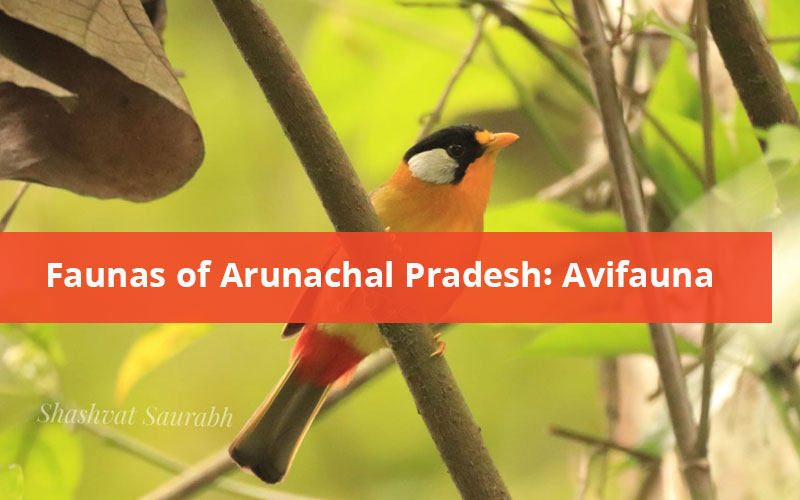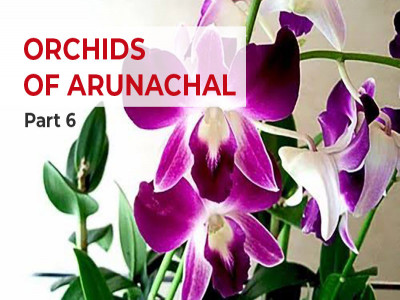
Faunas of Arunachal Pradesh: Avifauna
The Eastern Himalayan range in
India where the region, Arunachal Pradesh falls, houses more than 400 species
of birds, making it a treasure trove for avifauna diversity. During a
3-day bird watching program on 13 April 2022, at Lungla Tawang, about 105 species
of birds were sighted by the birdwatchers. Some of the magnificent birds that
were spotted in the event were 'The Ultramarine flycatcher', 'Khalij Pheasant',
'Bhutan Laughingtrush', 'Blyth's swift' etc. amongst others.
The state is also home to several
common, rare, and endemic wildlife species.
Avifauna Diversity in Arunachal Pradesh
The White-Winged Duck (Asarcornis scutulata)
Belonging to the family of
Anatidae, the white-winged duck, also known as 'The White-winged Wood Duck' is
one of the largest species of ducks. They are a kind of reclusive species
recorded as the species that only feeds at night. Its food includes grains,
rice, snails, tiny fish, seeds, aquatic plants, and insects. They can be
witnessed in or near evergreen, deciduous, or swamp forests. In India, the duck
is endemic to the North-East region of eastern Assam and along the border areas
of Arunachal Pradesh. Due to a decrease in their population, the white-winged
duck is listed as endangered on the IUCN Red List of Threatened Species.
The Whiskered Yuhina (Yuhina
flavicollis)
The Whiskered Yuhina is a type of small songbird within the white-eyed family of Zosteropidae. Like all the other Yuhinas, it is an extremely social species, and also tends to be a very anxious bird who moves around a lot while searching for insects. Its range habitat extends through the Himalayan forests in Northern India to the Northeastern Indian provinces. These species of Yuhina live on the forest canopy and can be found thriving in the subtropical, tropical wet montane forests, or the lower and medium levels of the mountainous broadleaf forests of Arunachal Pradesh such as the Mishmi Hills where about 680 different species of birds can be witnessed. Although not conclusive, researchers believe that the Whiskered Yuhina are the most common Yuhinas.
Green-tailed Sunbird (Aethopyga nipalensis)
This beautiful species of bird also
known as the 'Nepal Yellow-Backed Sunbird' or more popularly known as
'spiderhunters', belongs to the family of Nectariniidae. The Green-tailed
Sunbird is a small-sized bird species with a myriad of distinct and stunning
colours; its male species can be easily identified by their colour- a blend of
crimson, metallic green-blue, olive, and yellow shades, meanwhile the female counterpart
can be identified by their greyish head and olive-yellow with paler underparts.
Its usual diet consists of nectar and insects and they naturally thrive in
temperate, tropical, subtropical or moist montane forests. One can witness
these birds at Eagle Nest Wildlife Sanctuary, West Kameng district of Arunachal
Pradesh.
Black-faced Laughingthrush
(Trochalopteron affine)
Another species of bird that is
known to be a social & vocal creature is 'The black-faced laughingthrush,
belonging to the family of Leiothrichidae. It is a species of bird that admires
residing in dense forests. During the breeding season, it is frequently seen in
pairs, and during the winter, it is more often seen in small groups in the
dense vegetation of hills and mountainous forests. They are primarily found in
the Eastern Himalayas and their range includes Arunachal Pradesh in India,
southern Tibet, Bhutan, Eastern Nepal, and Myanmar. In Arunachal, this variety
of birds can be observed in Eagle Nest Wildlife Sanctuary, India's birding
paradise, where a few of the precious and rare species have been spotted and
recorded.
Blood Pheasant (Ithaginis
cruentus)
The blood Pheasant is a mid-sized bird that belongs to the family of Phasianidae. It is known as 'The Blood Partridge' and is the only known species in the genus Ithaginis of the pheasant family. It is the streaks of reddish-crimson colour on their body (chest) that sort of imitates blood splashes, which is where they earn their name from. They can be identified by their features, red plumage on the male's head & red marks on the chest. This particular species. Blood Pheasant is truly one of a kind, they are speculated to be monogamous creatures that mate with one partner for life. Also, they prefer running because they are not skilled in flying, almost as if they were flightless birds. Hence, building their nests close to ground-level areas. They are omnivorous, and feed on beetles, flies, mosses, lichens, and pine shoots; and can be mostly found in the Eastern Himalayan regions at higher elevations in the mixed or coniferous forests types of habitats ranging in Arunachal Pradesh, Sikkim and Darjeeling Hills of India, Nepal, Tibet, China, and Myanmar. The species is currently classified as Least Concern on the IUCN Red List.
Arunachal Pradesh is a land of the indigenous people and the tribal people are traditionally omnivorous and feed themselves by farming and hunting for food since time immemorial. Apart from the illegal poachers and trophy hunters, the native tribal people in the villages are naive and don't understand the restrictions and the consequences of hunting down rare and exotic species. But the Government of Arunachal Pradesh is working towards conserving nature and protecting its wildlife species. Hence, they came up with the Airgun Surrender Abhiyan, a noble initiative where the citizens of the state are voluntarily giving up their guns/firearms (otherwise used for hunting) in support of eliminating hunting and preserving wildlife. Since the launch of the campaign in 2021, during the recent three-day winter migratory bird survey in Ziro (Arunachal Pradesh), a total of 14 migratory birds was recorded, of which, three new species of Spotted Redshank, Black-headed Gull, and Peregrine Falcon have been added to the new checklist.
Disclaimer: The opinions expressed in this article are those of the author's. They do not purport to reflect the opinions or views of The Critical Script or its editor.

Newsletter!!!
Subscribe to our weekly Newsletter and stay tuned.

















Related Comments